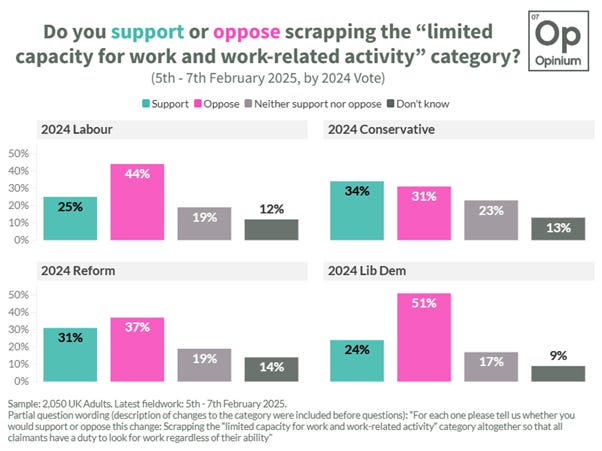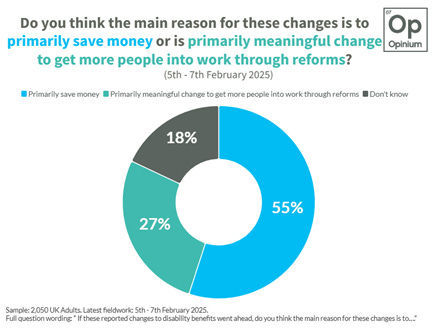Labour’s balancing act on welfare reform
Priya Minhas examines public opinion on potential benefit cuts and the challenges Labour faces in implementing reform
Welfare reforms appear to be next on the Labour Government’s agenda. In the coming weeks the government will release the Health and Disability Green Paper to address shortcomings in the current system. We can expect to see a focus on measures to help get more disabled people into work, and a close scrutiny of the increasing cost of the benefits bill. Since 2013, disability and incapacity benefits have increased by over 40% and currently sits at £64.7 billion. By 2029/2030 this is predicted to increase to £100.7 billion. Any cuts could spark a pushback among charities and some supporters, leading to a fine balancing act between try to achieve meaningful reform while mitigating against increasing costs that are seen to be unsustainable in the long run.
Labour is rumoured to be considering several welfare reforms, including tightening Work Capability Assessments to classify more people as “job searching,” scrapping the LCWRA category, restricting PIP eligibility for mental health conditions, and shifting PIP to one-off payments instead of monthly support. Public reaction is mixed—while some changes, like tightening WCAs, have a fairly even split in opinion, more drastic measures, such as removing LCWRA or altering PIP payments, face significant opposition, particularly from those directly affected. Labour will need to navigate these challenges carefully to gain public support.
Public perceptions of disability and incapacity benefits
Before we get into the polling evidence, let us remind ourselves about the current definitions of PIP and Universal Credit-LCWRA groups, which are the disability benefits that are rumoured to be under scrutiny.
Those that have a health condition or disability that limits how much they can work, currently would often have a work capability assessment (WCA) carried out when they apply for Universal Credit. The WCA is used to find out how much someone’s health condition affects their ability to work. A decision is then made on whether someone is:
· Fit for work
· Has limited capability to work (LCW) but need to prepare to work in the future
· Have limited capability for work- and work-related activity (LCWRA) and don’t have requirements to look for work
Personal Independence Payments (PIP) are provided to those with additional costs associated with a disability or long term physical or mental health condition and is not subject to employment status.
Overall, most of the public don’t think it is easy to access these benefits, with 42% thinking that it is difficult to qualify for the LCWRA group, and more perceiving qualifying for PIP payments to be difficult (49%).
Perceptions of potential changes to disability and incapacity benefits
We tested some of the potential rumoured changes to see how much public support there would be for these.
Restricting the criteria for Work Capability Assessments so that more people are classified as “job searching” rather than “limited capability for work and work-related activity”
· Voters were split on this with just over a quarter (28%) supporting such a policy compared to 23% opposing it, 29% neutral and one in five unsure.
· Those on Employment Support Allowance (ESA is a legacy benefit provided to those with disabilities or health condition that affect their work) or LCWRA, the two groups that would be impacted by this, were more likely to be opposed (46% opposed compared to 13% in support)
Scrapping the “limited capacity for work and work-related activity” category altogether so that all claimants have a duty to look for work regardless of their ability
· Voters were much more opposed to this suggested change, with 40% opposed compared to 25% in support.
· Again, those on ESA or LCWRA, were more likely to be opposed (58% vs 15% in support)
· Labour, Liberal Democrat and Green voters were much more likely to oppose this change than support it, while Conservative voters were split in opinion, and Reform voters were split but more likely to oppose than support
Restricting the eligibility criteria to make it harder to claim PIP for mental health conditions
· The public were split on this potential change. 33% are opposed, 30% are in support and 23% are neutral.
A blanket shift of Personal Independence Payments (PIPs) to one-off payments for specific things when they are needed by PIP claimants, instead of providing a regular monthly amount of money
· The public are also divided on this potential change. A third (34%) oppose this, while 27% are in support and 23% are neutral.
What these perceptions indicate about the challenges Labour face with welfare reforms
The policy proposals tested are only rumoured changes, however the polling shows that the government faces several challenges they will need to grapple with when proposing any reform that involves benefit changes:
Getting their own voters on side with changes to eligibility
None of the current rumoured changes we asked about have outright support from 2024 Labour voters. Labour voters were split on restricting the criteria for Work Capability Assessment, so more people classified as “job searching” rather than “limited capability for work”, with 31% in support and 26% opposed. This split was slightly bigger on whether PIP eligibility criteria should be made harder for those with mental health conditions (39% oppose vs 30% support).
However, much less palatable to Labour voters is the idea of scrapping the “limited capacity for work and work-related activity” entirely and making these people look for work regardless of their ability to work (44% opposed vs 25% support).
When making changes on who must look for work, and bringing their voters along with them on this, Labour will need to convincingly explain what their plans are for those that cannot work, and how they will decide who cannot work if it differs from the current criteria and why.
Getting people impacted by these benefit changes on side
The government will be consulting with disabled people about the welfare changes they will be putting forward. Building trust is key to successfully delivering reforms. They will need to mitigate concerns that people on the benefits being discussed may have about the impact any changes could have on them and assure them that any support being offered is appropriate meaningful support rather than a means to reduce the benefits bill (see challenge below).
Communicating the purpose of these changes
Despite the government over recent weeks having spoken about disabled people who don’t work wanting to get into work with the right support, currently over half of voters think that if these reported benefit changes went ahead the main reason for these changes would be primarily to save money (55%), as opposed to primarily being about meaningful change to get more people into work through reforms (27%). Whether the focus of discussions on these reforms ends up being on the cuts or on the support into work policies will have a big impact on perceptions. The government has a lot more work to do to influence the focus of public discourse being on the latter when the reforms are announced.
Convincing voters that welfare changes would improve the lives of disabled people and those unable to work.
If these reported changes to disability benefits discussed in this article went ahead, two fifths (44%) of the public think that disabled people would be worse off in the long run, with only 10% thinking they will be better off.
Furthermore, any changes that are perceived to result in people losing out who shouldn’t be is less likely to have people onside even if it is communicated as an attempt to tighten the criteria to those that need it most. The public are more likely to lean towards thinking that “it is worse if a person who does deserve benefits can’t get them” (46%) than thinking “it is worse if a person who doesn’t deserve benefits receives them” (32%).
Therefore, support measures that are to put in place have a big negative perception that is inbuilt around restrictions to offset.
A shorter publication of this article can be read in Lansons-Opinium Political Capital.






